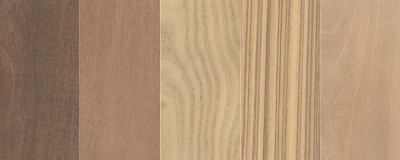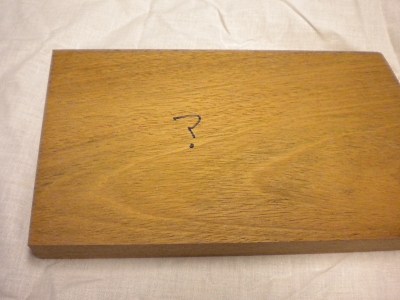After having personally worked with hundreds of wood species, (obviously some much more than others), and having read a number of books and articles on wood identification, I’ve come to an unsettling conclusion: it seems that the more I learn and discover, the more I realize how very little I know. The more accurate and thorough my identification process becomes, the more certain I become that I really cannot guarantee that I am correct.
THINK YOU’RE A KNOW-IT-ALL? TAKE THIS TEST TO SEE HOW GOOD YOU REALLY ARE!
HYPOTHETICAL SITUATION:
A wood-collecting friend approaches you with five different wood samples, and asks you to identify them. You ask them where they came from, and they just shrug their shoulders and hand you the samples. You have nothing to go on except the facegrain of the wood itself. This is what you see:

So, what are your guesses? Well, if you had deduced any of the woods that I initially guessed, then you’d get a score of zero! Here are the actual identities of the woods above, from left to right:MY GUESSES:
- Black walnut – Color and grain look right, and it’s a common hardwood, so it’s a solid guess; weight is a bit high: is this board still drying?
- Honduran mahogany – Grain might be a little plain, but the pattern looks right, and the weight feels close.
- White ash – The color and coarse grain looks like ash, though the weight seems a bit too light: maybe the sample is from a very dry location?
- Zebrawood – What other wood has this kind of zebra striping? Most likely quartersawn since the stripes are so uniform.
- Black cherry – Color and grain are similar, and the weight feels right-on, eliminating heavier fruitwoods like apple.
Do you see how my ability to accurately identify wood based upon intuition was tainted by my own experiences of what I thought were “regular” woods? I named woods that I was used to working with, but for different people, in different parts of the world, this set of intuitive guesses might be totally different. A person in China or Australia might have five totally different guesses than mine, and all could be completely wrong guesses, with each person equally self-assured and unable to sufficiently articulate their position.CORRECT ANSWERS:
- Black mesquite – A fair amount heavier than walnut, also diffuse porous with vasicentric to aliform parenchyma.
- Andiroba – Well, it’s brown… does that help? There are a bunch of Mahogany lookalikes: it’s not always easy to tell them apart.
- Sassafras – Very similar in appearance to ash, but slightly lighter in weight, and with a spicy odor.
- Beli – Zebrawood isn’t the only wood that is striped. Beli has heavily vasicentric parenchyma, while Zebrawood’s parenchyma tends to be diffuse-in-aggregates.
- Sourwood – Not only was it not Cherry, it wasn’t even in the fruitwood/rose (Rosaceae) family!
THE TRUTH IS, IT’S A CRAPSHOOT
Probably the most common means of identifying wood among woodworkers is to simply eyeball the facegrain of the wood sample, and allow some sort of unspoken instinct or imperceptible intuition to just pop into their heads with the right answer. Using this quasi-magic “second-nature” method to accurately identify wood down to a genus and species level is not only unscientific, unhelpful, and unteachable, it’s a crapshoot.
GREAT EXPECTATIONS
This limitation usually isn’t in the methods or means of identification, but in the wood itself. In botany, a tree species is not classified and described by its wood, but rather, by its leaves, bark, flowers, seeds, fruit, etc. Oftentimes, there are just not enough uniquely identifying characteristics present in the wood of each species to clearly and authoritatively differentiate it from another—not even when viewed under a microscope.
Furthermore, trees occur throughout a variety of natural environments, so the wood exhibits a surprising amount of variability. This is part of what makes woodworking so enjoyable: no two boards are quite the same; but this same variation can also frustrate many identification procedures, and confuse us by the apparent lack of consistency.
The problem is mostly with our expectations: we want to know exactly what kind of wood that we have. We expect just by examining it, that there is some indescribable way of deciphering down to the species level what type of wood is set before us. Sure, we might be able to narrow a sample down to maple, and tell that it is from the Acer genus, but that’s not enough: we want to come up with something like Acer pseudoplatanus. In the majority of cases, that level of precision is just not possible.
But further compounding the problem is that some of the most useful information is contained in a clear and magnified view of the endgrain. Simply viewing the facegrain of a wood sample with the naked eye puts an even greater limitation on our ability to identify it accurately.
One of the worst things that we can do is arrogantly convince ourselves that we can indeed tell one species apart from another when, given the available data, we simply cannot. If we just go by intuition and take an unsubstantiated guess, we’ll quite likely guess wrong.
FILL IN THE BLANK, OR MULTIPLE CHOICE?
Of course, if we had restricted this exercise only to the most commonly used hardwoods, then the identification process would’ve been much easier. But in real-world situations, it’s seldom that simple. It’s one thing to find a misplaced board at a lumberyard and reason, “this must belong in one of these piles” and have our expansive quest reduced to a simple multiple-choice test question.

Or suppose that we were at an Amish furniture shop in Pennsylvania, and we knew that they mill and process all their own timber: the choices would be significantly narrower, and the source of the lumber would be more obvious. We would logically deduce that the wood had to originate from a region nearby, and must be limited to only those trees that are native to the northeastern United States. This is what we call provenance: when we know with a fair degree of certainty where a wood sample came from.
A difficulty for us amateur wood detectives (in addition to the absence of unique identifiers already lacking in the wood itself), is that we usually have little to no information about the origin of the wood. The wood just showed up from somewhere: it was pulled from someone’s dusty garage shelf, or it was taken from an obscure pallet or crate, or it was discovered second-hand at a garage sale. While certain woods are certainly much more common than others, this lack of a reliable source leaves the door wide open to the big, broad, vast expanse of this tree-covered globe. Our number of choices—even among commercially viable timber-producing trees—is staggering, to say the least. We are essentially being asked to fill in the blank. Even a printed volume that encompasses several hundred commercial (and many non-commercial) wood samples would be insufficient to address each and every possible wood species that is and has been in use.
WHEN WOOD IDENTIFICATION WORKS
Of course, there are certainly times when wood identification is very useful and reliable. While there are typically not enough unique characteristics to identify a particular species (i.e., Acer pseudoplatanus), oftentimes—especially with many temperate-zone hardwoods found in the United States—there will be enough information present to reasonably identify a sample down to the genus level (i.e., Acer spp.). We may not be able to take a wood sample and pronounce, “this is Quercus laurifolia—Laurel Oak.” But we should be able to identify that it is in fact an oak, in the Quercus genus. And from there, we may even be able to identify it down to a sub-genus level, and say it is in the red oak group.
But another advantage in wood identification lies in the fact that even though it seems we have no clues to go on, we can usually make some safe assumptions or inferences about a wood sample’s provenance.
For instance, if we see some wooden kitchen cabinets out in a rustic country cabin, it would be reasonable to assume that most cabinet-makers in the area would’ve used a domestic hardwood species. There are only perhaps a few dozen native hardwoods commonly used for cabinetry in the United States, which narrows our options down significantly. In this instance, if we have much experience in domestic hardwoods at all, we should be able to eyeball and/or spot the differences between maple, beech, oak, walnut, etc. relatively easily. (Further examination might then confirm or deny our initial designation.)
But if we were in a fancy, upscale city restaurant where all the woodwork looked foreign and unfamiliar, or we were in a distant locale such as South Africa or Thailand, then the story would be much different, and a much different set of assumptions—perhaps a set unknown to us—would have to be used. (For more information on these types of deductive identification methods, please see the page entitled Wood Identification Guide.)
BE HONEST
We might as well be honest with ourselves: sometimes wood identification is an uncertain thing. So long as we maintain proper expectations of the identification procedure, and recognize that we might not have all the answers, wood identification can be a useful and enjoyable pursuit. Sometimes the most accurate answer that we can expect to uncover through diligent and thorough examination is simply a question mark.





